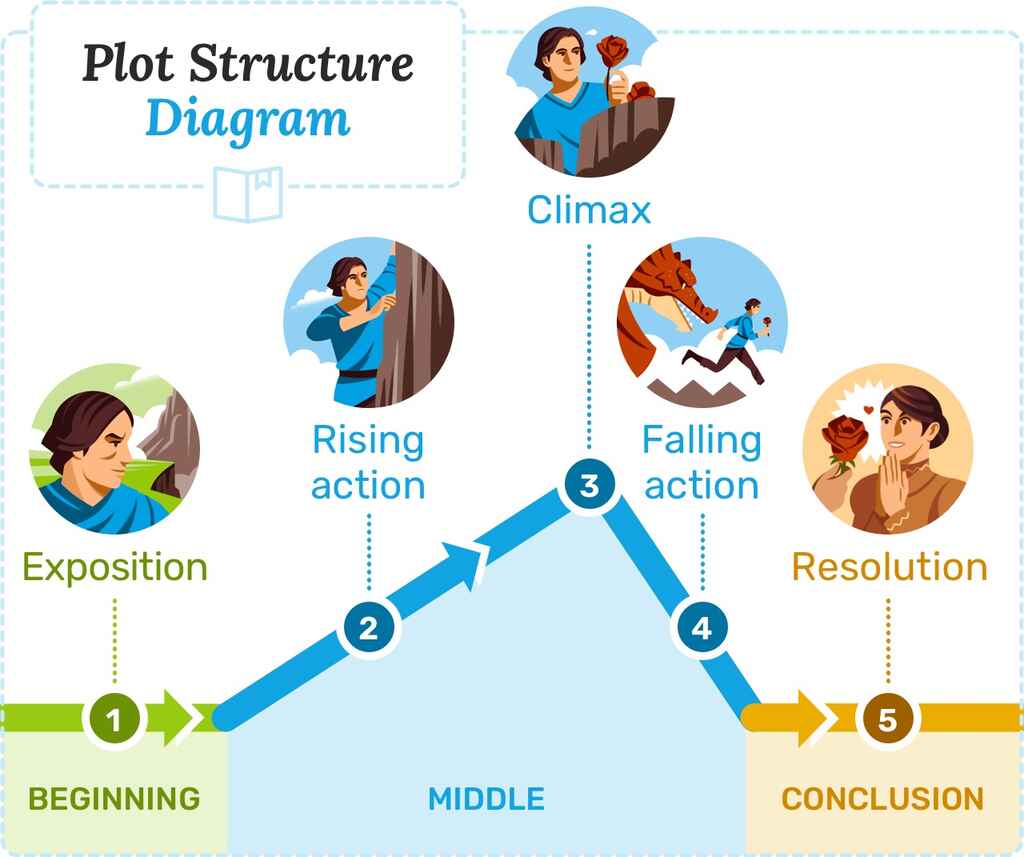Guides • Perfecting your Craft
Last updated on Nov 07, 2023
What is Plot? An Author's Guide to Storytelling
About the author
Reedsy's editorial team is a diverse group of industry experts devoted to helping authors write and publish beautiful books.
More about the Reedsy Editorial Team →About Martin Cavannagh
Head of Content at Reedsy, Martin has spent over eight years helping writers turn their ambitions into reality. As a voice in the indie publishing space, he has written for a number of outlets and spoken at conferences, including the 2024 Writers Summit at the London Book Fair.
Learn more →So, what is a plot in fiction? Let's check your understanding with a pop quiz: which of the following is the best example of a plot?
a. A boy finds a new family in a traveling circus run by orphans.
b. An immigrant comes to the United States to start a new life.
c. A king dies and then the queen dies out of grief.
d. A high school girl discovers love from an unexpected source: a centuries-old vampire.
If you picked c, you’re right.
But what about a, b, and d? Well, strictly speaking, those are a mix of themes and premises, but the confusion is entirely understandable. Storytelling theory is packed with confusingly similar terms — and as you get further into the nuts and bolts of writing narrative, it helps to know the difference.
This post is here to help make sure that you don’t lose the plot when you’re writing your own story. But before we get that far, let’s first define plot.
What is plot?
Plot is the sequence of connected events that make up a narrative in a novel. Generally, a plot in fiction builds up to a climax and ends in a resolution at the finish of the story.
Of course, plot is one of storytelling’s major pillars. Some will say that if characters are the who and theme is the why, then the plot is the what of the story.
It is not a series of random incidents. There usually must be a cause-and-effect relationship between the events and the plot points. The king died and then the queen died, for instance, is not a plot, as E.M. Forster notes. But the king died and then the queen died out of grief is one because it reveals a causality in the sequence of scenes.
Plot is an incredibly complex thing. It is a key element of establishing your book in the literary community and into the hearts of readers. We as humans have become increasingly story aware—especially within the internet age, where countless stories are only a click away—and readers come to a story with high expectations, both on the conscious and subconscious level.
— Chersti Nieveen, editor of multiple NYT bestsellers
So what is a plot diagram?
Structuring a story is a bit like a puzzle: it’s easy to jumble up all the moving pieces if you keep them all in a list (or, god forbid, in your head). That’s why many authors find it useful to turn to a plot diagram to visualize the structure and track every major “beat” in a story.

Now that you’re all caught up, it’s time to dive into some of the most popular plots in the history of literature. As you go through these plot examples, see if you can use the plot diagram to understand where each falls in the context of its plot structure.
What are some typical examples of plot?
Since the dawn of time, there have been millions of unique stories by writers, bards, and raconteurs. But can all of them be grouped into just a few master plots? According to journalist Christopher Booker, they can. We’ve taken a leaf from his book to show you some popular examples of plot.
Overcoming the Monster
A protagonist must defeat a threat to society. Sound familiar? If that rings a bell to you, that’s because this plot type is old as time: you can trace it all the way back to Beowulf (who needed to destroy Grendel) and Theseus (who needed to kill the Minotaur). That said, it doesn’t need to be an otherworldly monster. The “monster” could be, for instance, the villain in James Bond, or the big bad weasel in Redwall.
Further examples of this plot type: Jurassic Park, Little Red Riding Hood, King Kong, Frankenstein, Hunger Games
Rags to Riches
Someone poor becomes someone rich or successful. You might’ve encountered this (generally) feel-good story in such classics as My Fair Lady and Aladdin. It gives readers a chance to participate in a universally beloved pastime: rooting for the underdog.
Further examples of this plot type: Great Expectations, Cinderella, Slumdog Millionaire, Jane Eyre
Quest
The protagonist and friends go out in search of something. It could be a MacGuffin (such as Indiana Jones searching for the Crystal Skull), which is by far one of the most famous variations. Or it could be a fellow fish, such as in Finding Nemo! No matter what, the object at the end of the journey is the Holy Grail of this plot type, so to speak.
Further examples of this plot type: The Lord of the Rings, Le Morte d’Arthur, Monty Python and the Holy Grail

Voyage and Return
The protagonist and friends go out on a journey — with a return ticket. This differs from the Quest in that there’s no ultimate item to find. Instead, they’re simply on an adventure.
Let’s take Chronicles of Narnia as an example. When the Pevensie siblings walk through the wardrobe, they’re thrust unexpectedly into the magical world of Narnia. It’s up to them to navigate this new reality before they can return a bit older (and a bit wiser).
Further examples of this plot type: Alice in Wonderland, The Wizard of Oz, Star Trek, Where the Wild Things Are, The Odyssey
Rebirth
Is that. . . the smell of redemption in the air? That’s the gist of this plot type, in which “rebirth” is metaphorical for somebody coming good in the end. You’ll commonly find themes of new beginnings and renewal — The Grinch Who Stole Christmas is a great example.
Further examples of this plot type: A Christmas Carol, The Secret Garden
There are infinite variations
As you might be able to tell, there’s no definitive way to categorize plots in fiction. This is just one sample. Author John Gardner once said that there are only two stories in the world: a man goes on a journey, and a stranger comes to town. Meanwhile, writer Ronald Tobias came up with 20 total master plots while French author Georges Polti topped that with 36 dramatic situations that can be found in fiction.
That said, it goes without saying that there are infinite ways to actually write a plot. Slumdog Millionaire and Jane Eyre might both, for instance, involve rags-to-riches stories. However, no one would take one look at them and shout, “Twinsies!” That’s because the uniqueness of the story largely depends on how you plot the book.
Tips from Our Editors: How to plot a book
Since you now know what a plot is (and what forms it can take), let’s visit a few of our top editors for some practical advice on plot writing.
Ask "and so...?"
Plotting a book invariably brings up the controversial topic of outlining. Should you properly outline a book or not? It depends on whether you’re a plotter or a pantser — each will approach writing differently.
That said, Randall Klein, a former editor at Penguin Random House, recommends all writers to try and have a rough sketch of the “big picture” before they start writing. This means “getting the big moments down on paper,” he says. This will help you make sure that the “and so” thread is prevalent between each your big events.
“Does your narrative drag in between the action set pieces? Is there a build-up missing here and there? It's easier to tell when you've outlined the main discoveries that the reader (and the character) will make.”
If you're interested in learning more about the outlining phase, you can read this post that's all about how to outline a novel.
Make the stakes high enough
A story needs stakes to get a reader invested. If Frodo needed to drop off the Ring at Mount Doom because he just didn’t like rings — and not because the fate of Middle Earth was hanging in balance — we wouldn’t exactly be gripping the edges of our seats, would we?
That’s why you need to “make the reader worry,” says Hannah Sheppard, an editor and literary agent. “Make them care whether the protagonist succeeds. To ensure that happens, the stakes must be significant. Why should the protagonist care beyond generally being a decent person?” Take that as a reminder that character and plot are inextricably connected — which leads us to our next point.
Know what your character wants and why
As Ray Bradbury famously once said, “Plot is no more than footprints left in the snow after your characters have run by on their way to incredible destinations.” So if you want to get your characters sprinting, you first need to understand them inside and out.
That means knowing why they want something, advises editor Fiona McLaren: “Before you put pen to paper or fingers to keyboard, find out why the character is going to go after their goal — not just on a superficial level, but down to their core beliefs. The deeper you dig, the more you develop your character’s motivations in life.” For a cheat sheet, we have a character template here you can download for free.

FREE COURSE
How to Develop Characters
In 10 days, learn to develop complex characters readers will love.
Remember that Goal + Flaw + Stakes = Compelling Narrative
Don’t forget about your character’s flaw, says editor Katie McCoach. “The flaw of a character must be the thing about them that needs to change in order to reach their goal at the end of the book, or another way of viewing it is to ask: what is their fear that keeps them from reaching their goals?” This should feed into the conflict of the story, which will be instrumental in guiding the structure.
Don't plot in a vacuum
Ever watch a movie or read a book where you shook your head because the characters were acting “out-of-character”? That author probably fell into one of the biggest temptations of plotting: letting the plot drive the characters. Avoid that, warns Aja Pollock, a former editor at Simon & Schuster:
“A lot of authors get the outline in their minds, but when the desires of their characters don't align with where the plot is going, rather than adjusting the plot or rethinking the characters, they shoehorn their characters into situations that don't make sense.”
In other words, even plot turns and twists need to make sense first and foremost. Forcing the plot along will result in characters who behave falsely in readers' eyes — which will make the whole story seem hollow.



1 response
Toshi says:
19/11/2019 – 02:24
The article was okay. And, I'm a supporter. Thanks